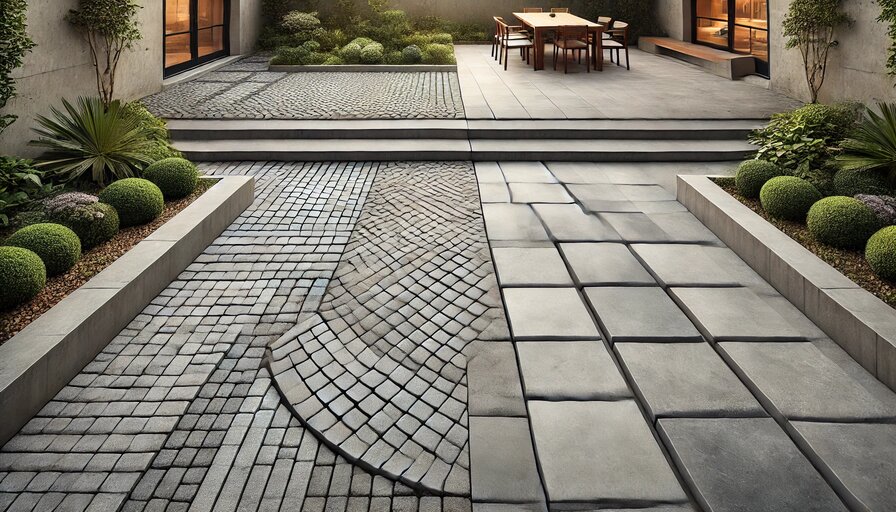When it comes to outdoor landscaping and construction, paving and slabs are terms that often come up, especially when you're working on driveways, patios, or pathways. While they are sometimes used interchangeably, they have distinct differences in terms of materials, applications, and aesthetics. Understanding these differences can help you make the right choice for your project, whether you’re aiming for durability, appearance, or ease of installation.
1. Materials and Composition
Paving generally refers to the use of smaller, individual units, called pavers, which are made from various materials. The most common materials include:
One of the main differences lies in the size and shape of the units:
Both paving and slabs have different installation processes:
When it comes to durability:
The aesthetic differences between paving and slabs are significant:
Generally, paving can be more affordable upfront due to the variety of materials available, especially when using concrete pavers. The cost also depends on the complexity of the installation, as intricate patterns may require more labor.
Slabs, especially those made of natural stone, tend to be more expensive due to the material cost and the effort required to install them. However, in some cases, the larger size of slabs may reduce labor costs compared to laying hundreds of small pavers.
Which Should You Choose?
The choice between paving and slabs depends on your project’s needs:
By understanding the key differences between paving and slabs, you can ensure that your outdoor space not only looks great but performs well over time.
1. Materials and Composition
Paving generally refers to the use of smaller, individual units, called pavers, which are made from various materials. The most common materials include:
- Concrete: Popular for its versatility and cost-effectiveness.
- Clay: Often used in traditional brick paving for its natural color and durability.
- Natural Stone: Materials like granite, limestone, or sandstone provide a more natural and elegant look.
- Concrete: Precast slabs are common, offering a range of textures and colors.
- Natural Stone: These slabs can be heavier and more expensive but provide a high-end, timeless appearance.
One of the main differences lies in the size and shape of the units:
- Paving typically consists of smaller, modular units that can vary in shape—rectangular, square, hexagonal, etc. This flexibility in shape allows for more intricate designs and patterns.
- Slabs are much larger in size and generally come in a square or rectangular shape, though they can sometimes be cut to different dimensions. Their large surface area means fewer joints, giving a more seamless look, but they don’t offer the same level of design flexibility as smaller pavers.
Both paving and slabs have different installation processes:
- Paving requires individual placement of each paver, which can be more labor-intensive, especially for intricate designs. However, the smaller size of pavers makes it easier to adjust them to curves and tight spaces. Proper installation includes preparing a base layer of compacted gravel or sand to ensure stability and longevity.
- Slabs are quicker to install because their larger size covers more area with fewer pieces. However, because slabs are heavier and bulkier, they require more effort and precision in placement. They are typically laid on a bed of sand or mortar for stability.
When it comes to durability:
- Paving tends to be more durable, especially for areas with heavy foot or vehicle traffic. The small individual units allow for better weight distribution and can shift slightly without cracking, especially if laid on a flexible base.
- Slabs can be more prone to cracking, especially under heavy loads, because they cover a larger area and any movement in the ground beneath them can affect the slab as a whole. However, high-quality natural stone slabs can be incredibly resilient.
- Paving can require more frequent weeding and joint filling, as the gaps between individual pavers can allow for weed growth. But if damage occurs, it's easier to replace one paver without disrupting the whole area.
- Slabs have fewer joints, reducing the chance of weed growth, but if a slab cracks or breaks, replacing it can be more challenging and costly.
The aesthetic differences between paving and slabs are significant:
- Paving offers a more detailed, patterned look, making it ideal for those who want to create intricate designs or decorative features. The variety of materials, colors, and shapes available also allows for greater customization.
- Slabs provide a more minimalist, sleek look. They work well for modern, contemporary designs or projects where a simple, clean finish is desired. Natural stone slabs, in particular, add a sense of luxury and timelessness to any space.
Generally, paving can be more affordable upfront due to the variety of materials available, especially when using concrete pavers. The cost also depends on the complexity of the installation, as intricate patterns may require more labor.
Slabs, especially those made of natural stone, tend to be more expensive due to the material cost and the effort required to install them. However, in some cases, the larger size of slabs may reduce labor costs compared to laying hundreds of small pavers.
Which Should You Choose?
The choice between paving and slabs depends on your project’s needs:
- For driveways and areas that will bear heavy loads, paving might be the better choice due to its durability and flexibility.
- For patios, pathways, or large open spaces where aesthetics are important, slabs may offer the clean, elegant look you desire.
By understanding the key differences between paving and slabs, you can ensure that your outdoor space not only looks great but performs well over time.
What is the Difference Between Paving and Slabs?
